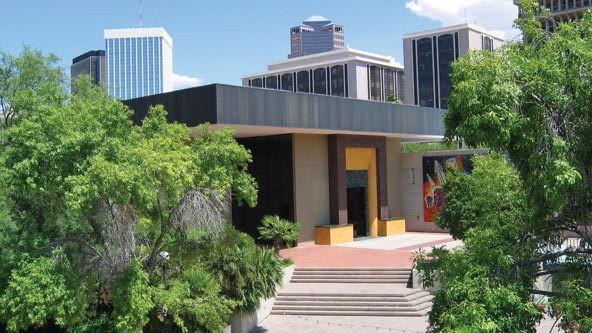If you’re interested in having a cultured weekend, now is the perfect time to head downtown to the Tucson Museum of Art. The final day of two special exhibitions, Spirit of the West and 100 Years, 100 Ranchers is Sunday. If you have even a passing interest in art, particularly in Western history, these displays will be captivating.
Spirit of the West contains a wide variety of Western-inspired art, with many pieces on loan from private collectors, ranging from modern paintings to photographs to Native American artifacts. Perhaps the best piece in this exhibition is a paint-by-numbers style piece called “Wyoming #44” by Bill Schenck, depicting a scene from the Sergio Leone spaghetti Western “Once Upon a Time In the West.”
While Spirit of the West is fascinating, the crowning achievement resides in the basement. 100 Years, 100 Ranchers is a project by photographer Scott F. Baxter many years in the making. As an official Arizona Centennial exhibition, it includes 100 photographs of modern ranchers, all belonging to families that have ranched in Arizona since, at least, statehood in 1912.
The black and white photographs depict ranchers from all across Arizona, from Navajo County in northern Arizona, to Cochise County in the south. It sounds simple, but the stories each image tell are incredibly powerful.
Brent Cline and his big black horse, Bear, stand for the camera in Pima County as an Arizona summer storm gathers in the distance. Warner Glenn’s long white hair frames his wise face, perhaps remembering the time he photographed one of the only jaguars seen in the United States, or so his caption says.
These are just some of the fascinating tales each image and its brief caption tells. Walking around the exhibition, the observer finds they must know each and every story, and that the stories and images stay with them long after.
Though there are a wide variety of people and locales, perhaps the most powerful photographs are simply the faces of the old men and women who have ranched all their lives. Their eyes tell more of a story than any caption or any scenery, and each and every one of them seems to carry the history of this beautiful land in their eyes. They are all living history, a link from Arizona’s past to its present that Baxter captures with artistic perfection.
Whether you are a longtime Arizona resident or a recent transplant, head down to the museum before Sunday so you can see this land enshrined in art. Take in this celebration before it’s gone for good.
Follow us on Twitter @wildcatarts









